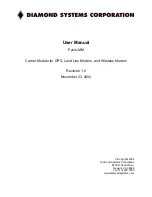
3.5
Settings
(continuation)
4
SYSTEMS WITH redoX CONTROL
The redoX value advises us of the oxidation/reduction potential and is used to determine the level of water sterilization. The parameters or setpoints are the minimum/
maximum accepted redoX levels before the titanium cell is connected/disconnected. Adjusting the ideal redoX level (setpoint) is the last step in the Station start up sequence.
To find the optimum redoX levels for your pool follow these steps:
Connect the pool filtration system.
Add chlorine to the pool till a level of 1-1,5 ppm is achieved (approx. 1-1,5 gr/ m3 of water). pH levels should be between 7,2 - 7,5.
After 30 min. test the free chlorine levels in the pool (manual test kit DPD1) if the free chlorine level is between 0,8 - 1,0 ppm. Look at the redoX screen and memorize this
level as the setpoint to CONNECT / DISCONNECT the chlorine pump.
The next day check free chlorine levels (manual test kit DPD1) and redoX. Raise / lower setpoint if necessary.
Remember to check the redoX set-point every 2-3 month and/or if the water parameters change (pH / temperature / conductivity).
1
2
3
4
5
WARNING
Keep chemical levels in pool as instructed in this manual.
EARTHING
All metallic components in the pool such as lamps, ladders, heat exchangers, drains or similar elements within 3 m from the pool
(10 feet) must be connected to an earth below 37 Ohms. If using heat exchangers, we recommend them to be made of titanium.
SECURITY
To avoid accidents, children should not handle this product unless supervised by an adult.
Children should be supervised at all times when in or near a spa, pool or jacuzzi.
5.8
5.9
5.6
5.11
5.7
5.10
5
MAINTENANCE
During the first 10-15 days your pool system will require more attention and the following care:
Make sure the pH remains on the ideal level (7,2 - 7,5). If the pH is unusually unstable and uses a lot of acid, check the alkalinity (recommended levels between 80 y 120 ppm).
The pool must be vacuumed and the skimmers cleaned whenever necessary to ensure perfect water conditions.
1
2
First days of maintenance
DOSING PUMPS: Check regularly to ensure that the container contains liquid to prevent the dosing pump of
running dry. The dosing pump requires maintenance (SEE INSTRUCTIONS ON BOX).
pH PROBES / redoX / CONDUCTIVITY: Probes must be cleaned whenever necessary (check every 5-6 months).
To clean the probe insert in distilled water (clear liquid). After each cleaning the probes must be calibrated.
Also: the probes should never dry out and must be kept wet if stored (when emptying the pool for winterizing,
make sure to store the measuring head in water).
1
2
General maintenance
1,0 - 2,0 ppm
7,2 - 7,5
FREE CHLORINE
pH:
Fortnightly checks
6
TROUBLESHOOTING
80 - 120 ppm
30 - 50 ppm
TOTAL ALKALINITY (TAC) pH:
CYANURIC ACID
Monthly checks
•
Check if ON/OFF switch is illuminated.
•
Check the connection wire between display and
motherboard.
•
Check fuse of the device 3.15 A – it could have
tripped due to overload.
•
Check the power supply 110V/60Hz –
230V/50Hz.
•
If problem persists contact TECHNICAL SERVICE
Blank display
•
The water is excessively hard and it
is unbalanced.
•
Balance the water and check
the cell, proceeding to clean it if
necessary.
•
Put 1 small bag of flocculant in the
skimmer and recirculate 24 hours.
White flakes in the water
•
The maximum dosing time (standard 200 min.) is accomplished
and the acid dosing pump stops in order to avoid the acidification
of the water.
•
To delete the message and to restart the metering press ESC ( ).
Do the following verifications in order to preclude errors on the
device: Verify if the pH probe reading is correct (if not, calibrate
the probe or substitute it with a new one); Verify if the acid/base
deposit is full and if the dosing pump is working correctly; Verify
the variable speed of the dosing pump.
Alarm AL3 and pH dosing pump stopped
5.9
Sound:
Programming of the system to emit sound for the functions:
Keyboard
(keys);
Notices
(pop-up message);
Alarms
(working alarm);
Filtration
(start of the filtration).
5.11
Password:
Allows to protect the access to the user´s menu by activating a password.
To enter your password press a combination of 5 keys and the system will memorize. If
you forget the password, there is a “master password”. Ask you installer/provider.
5.12
Time info:
The system memorizes the operation times of the different modules and
they are displayed on the screen.
5.13
System info:
Information about the available software version of the TFT display and
the power module. It also shows the ID node which is necessary for the configuration of
the WIFI connection of the system.
5.12
5.14
5.13
2 x





















